Il richiamo degli elementi naturali, in particolar modo quelli più ingovernabili dall’uomo, ha sempre esercitato grande fascino negli artisti che a volte hanno persino sfidato il gusto e le convenzioni dell’epoca in cui hanno vissuto pur di raccontare il contatto diretto con il mondo circostante; nell’era attuale la natura diviene a volte un modo per esprimere il desiderio di tornare a un modo di vivere più semplice e genuino, in altre rappresenta un mondo fantastico e irrealmente misterioso e poi ci sono quelle in cui l’impetuosità si accorda con gli stati d’animo del singolo artista. La protagonista di oggi rappresenta la natura dal suo lato più tranquillo, entusiasmante nella sua immediatezza e in grado di donare una sensazione armonica all’osservatore.
Il mondo artistico dell’Ottocento e dei primi cinquant’anni del Novecento ha subìto delle forti e radicali trasformazioni sia dal punto di vista dei soggetti rappresentati sia da quello stilistico e tecnico perché è stato proprio a partire dal Diciannovesimo secolo che si sono delineati quei primi accenni rivoluzionari da cui poi si sono sviluppati e ampliati i movimenti avanguardisti del Ventesimo. Già con il Romanticismo, in particolar modo con il Romanticismo inglese di William Turner, il paesaggio ma soprattutto gli eventi atmosferici più travolgenti e impetuosi divennero protagonisti di tele in cui l’uomo non era più protagonista assoluto, al contrario ne veniva sottolineata l’esiguità, l’irrilevanza, davanti alla forza della natura; l’impianto pittorico era distante da quello del coevo Realismo, sia per l’utilizzo della luce sia per le pennellate decisamente meno precise perché funzionali all’effetto spettacolare e travolgente che l’artista voleva infondere nell’osservatore. Fu proprio da quel primo accenno di suddivisione dell’immagine, in sottili linee circolari, concentriche ed ellissoidali per concentrare il focus sul centro della tela utilizzate da Turner, che nacque qualche decennio dopo la corrente dell’Impressionismo in cui venne sdoganata la pittura en plein air, senza progettare un disegno e con l’immediatezza riproduttiva della scomposizione dell’immagine attraverso brevi e rapide pennellate che avevano la doppia funzione di permettere ai colori di avere una maggiore luminosità e intensità proprio in virtù del loro non essere più mescolati bensì accostati in maniera armonica, e di permettere di terminare l’opera in tempi rapidi, prima che la luce cambiasse e modificasse il paesaggio. I panorami, i giardini, i laghi di Claude Monet, di Pierre-Auguste Renoir, di Alfred Sisley, avevano il potere di incantare e al tempo stesso infondere nell’osservatore quello struggente senso di realtà avvolto dalla poesia che arrivava a far vibrare le corde emotive, a dispetto della ricerca estetica che invece era alla base del movimento stesso. Fu però con l’Espressionismo che tutti i canoni tradizionali furono sovvertiti per lasciare spazio alla pura manifestazione interiore in virtù della quale tutto, personaggi e paesaggi, dovevano accordarsi allo stato emotivo dell’esecutore dell’opera; sulla base di questa traccia non esisteva più una ricerca estetica che avrebbe solo controllato e ingabbiato la libera espressione delle sensazioni, né una regola coloristica o prospettica così come interpretata dalla pittura accademica. La dissoluzione della forma e la tensione verso la purezza del sentire indusse alcuni artisti ad avvicinarsi a una forma più astratta, seppur sempre molto emozionale, quella dell’Espressionismo Astratto.
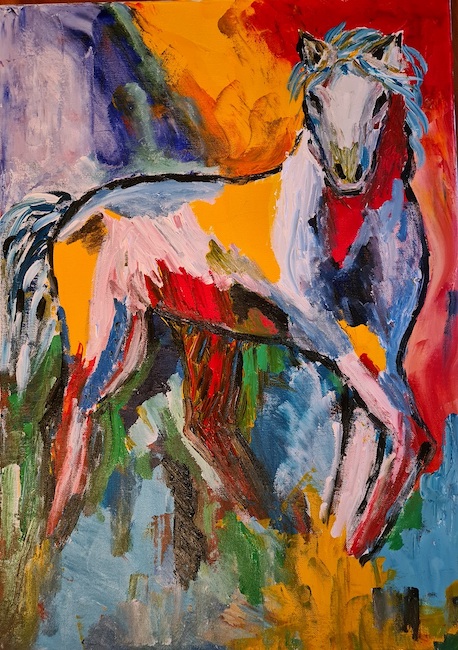
L’artista ligure Mariella Tissone si muove in una terra di mezzo tra l’Espressionismo in cui la figurazione resta, seppur lieve, protagonista essenziale dei paesaggi che racconta, e l’Astrattismo senza porre l’accento sull’impetuosità, sull’urgenza di gridare un’emozione diversamente inascoltata, bensì con la serenità di un temperamento in armonia con se stesso ma anche con tutto ciò su cui lo sguardo si posa. Il cielo e il mare sono i soggetti che più di altri preferisce ritrarre, con la loro tendenza all’infinito che induce l’essere umano a sentirsi più piccolo eppure avvolto dal loro rasserenante azzurro e dalla tranquillità che si manifesta attraverso lo sguardo morbido e carezzevole della Tissone, come se tutto fosse legato a un ricordo piacevole, a momenti condivisi e permanenti nella memoria visiva ed emotiva. I luoghi narrati sono scorci reali e in alcuni casi anche irreali, la personale idea dell’artista su come potrebbero essere quei regni sognati che tuttavia entrano a far parte dell’immaginario collettivo, del desiderio innato dell’uomo di conoscere e scoprire l’inconoscibile.

Ecco dunque che la tela Paradiso identifica il posto evocato dal titolo con un paesaggio visto e racchiuso in un cassetto della sua memoria emotiva, un’ambientazione che potrebbe trovarsi ovunque e da nessuna parte perché ciò che conta davvero è la sensazione che scaturisce guardandola, quel senso di pace interiore, di calma, di rilassatezza a cui si pensa ogni qualvolta viene immaginato il sito legato alla pace per definizione. Le tonalità giocano sui toni dell’azzurro, colore che conduce alla distensione e al sogno, alternato ai rosa, ai verdi, ai bianchi, come se sospese sul manto del fondo si trovassero delle isole di vita, quella piacevole e bella di chi sa guardare il quadro generale, quel cogliere l’insieme con sguardo sorridente in virtù del quale la vita non è un ottovolante di ostacoli e impedimenti bensì un mare in cui perdersi fiduciosi e lasciarsi andare alla corrente.
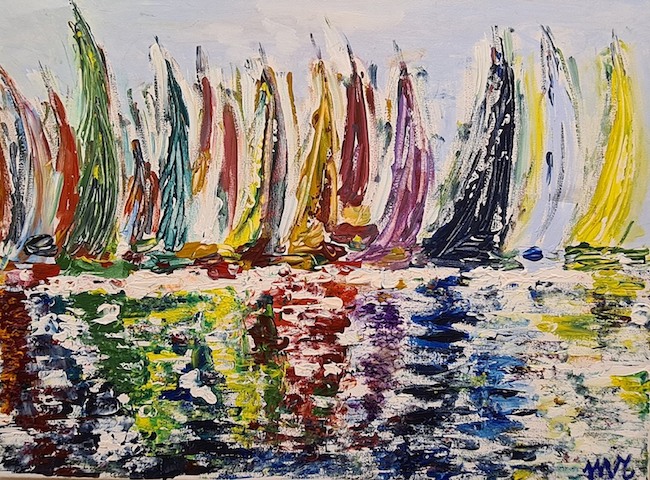
In Vele riflesse, opera ancora legata all’Espressionismo sebbene tendente verso la dissoluzione dell’immagine in virtù della forza emotiva percepita osservando il paesaggio descritto, Mariella Tissone conduce lo sguardo verso una visione d’insieme che sembra oltrepassare la realtà per entrare nel mondo entusiasmante di un giorno trascorso al mare osservandone la vivacità donata da una regata, dai colori delle vele che si rispecchiano nell’acqua togliendole la consueta tonalità azzurra per assecondarla a tutto quanto sta accadendo nella superficie; il visibile, reso da sapienti pennellate frastagliate in virtù delle quali la veduta d’insieme si riesce ad avere solo allontanandosi dalla tela, si mescola con un andare verso l’astrazione che tutto confonde, che tutto rende meno certo e definito, proprio come la realtà in cui il punto di vista modifica completamente la sensazione che ciascuno riceve dal medesimo paesaggio, oggetto, circostanza.
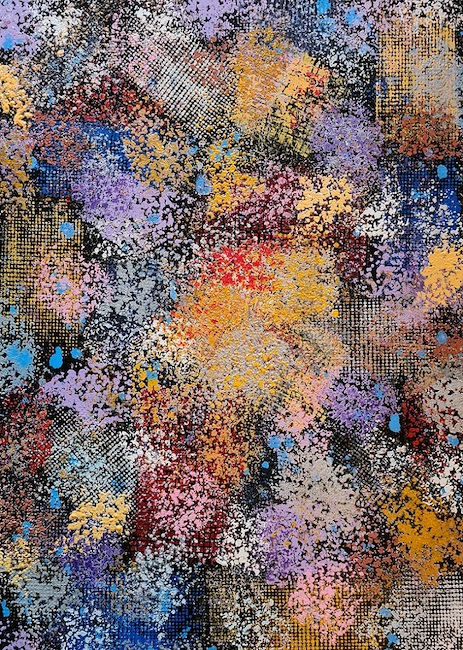
In Nebulosa nera il fascino del mistero si arricchisce del desiderio di essere spiegato, di quell’immaginare un’essenza inarrivabile che viene rappresentata dalla Tissone attraverso un’esplosione di colori, perché il buio nell’universo non esiste così come non esiste nell’animo umano se si sceglie di osservarne la luce, la luminosità di tutto ciò che appartiene al vissuto. Le macchie di colore divengono dunque metafora delle emozioni umane, quella vivacità di circostanze in grado di arricchire l’esistenza, indipendentemente che siano positive o negative perché in fondo ciò che conta davvero è il percorso che ci inducono a intraprendere.

In Trame blu si sposta decisamente verso un Espressionismo Astratto in cui emerge tutta la sua capacità riflessiva, l’attitudine a osservare con pacatezza quanto accade nella realtà che vive, di momento in momento; le trame altro non sono che quella consequenzialità di eventi, di accadimenti che portano l’individuo in contatto con se stesso e con chi percorre con lui un periodo più o meno breve ma sempre incisivo e fondamentale.
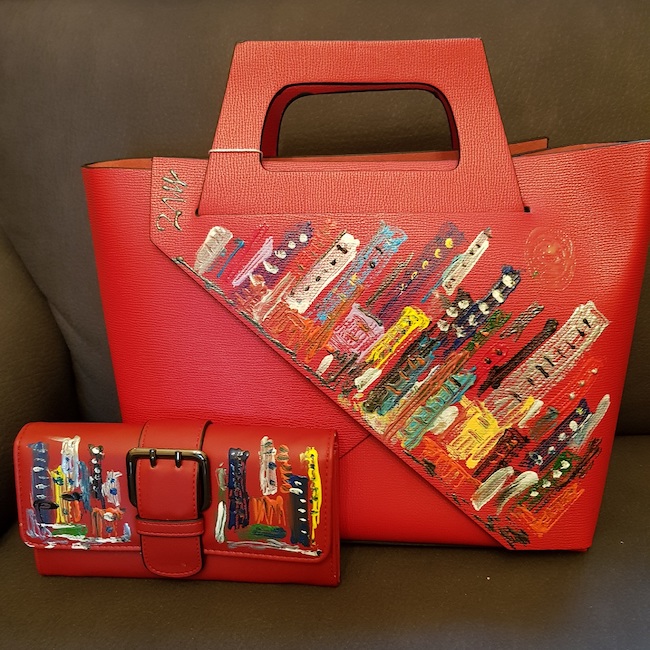
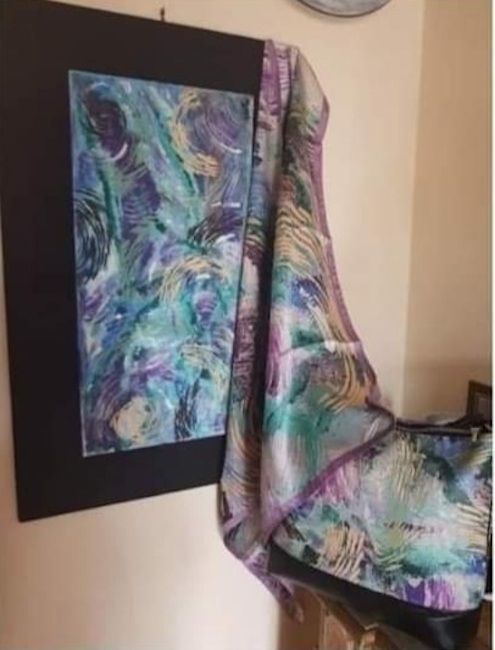
A lungo distante dal suo lato più creativo che si è manifestato nel momento in cui ha chiuso anticipatamente un lungo percorso professionale, nel momento in cui si è posta in posizione di ascolto della sua interiorità, della sua naturale attitudine, ha cominciato a liberare quell’estro sopito che l’ha condotta non solo verso la pittura bensì anche verso la produzione di accessori moda come borse e foulard nei quali riproduce alcune delle sue opere più iconiche per dar vita a oggetti unici in grado di rendere l’arte più accessibile anche al grande pubblico. Mariella Tissone ha all’attivo la partecipazione alle più importanti mostre e fiere italiane, ha esposto le sue opere in collettive internazionali in Polonia, in Portogallo, a videoesposizioni in Russia e in Qatar ed è presente nei più importanti cataloghi italiani di arte moderna e contemporanea; è presidente di un’associazione di teatro amatoriale, Boccascena, e ha pubblicato una raccolta di poesie.
MARIELLA TISSONE-CONTATTI
Email: sim.mari@libero.it
Facebook: https://www.facebook.com/mariella.tissone
Instagram: https://www.instagram.com/mari.tiss/
Suspended between sea and sky, the rarefied atmospheres of Expressionism by Mariella Tissone
The call of natural elements, especially those most ungovernable by man, has always exercised great fascination in artists who have sometimes even challenged the taste and conventions of the era in which they lived in order to recount direct contact with the world around them; in the current era nature sometimes becomes a way of expressing the desire to return to a simpler, more genuine way of life, in others it represents a fantastic, unrealistically mysterious world, and then there are those in which impetuousness is in tune with the mood of the individual artist. Today’s protagonist represents nature from its quieter side, exciting in its immediacy and able to give a harmonious feeling to the observer.
The artistic world of the nineteenth century and the first fifty years of the twentieth century underwent strong and radical transformations, both from the point of view of the subjects represented and from the stylistic and technical point of view, because it was from the nineteenth century that were outlined the first revolutionary hints from which the avant-garde movements of the twentieth century developed and expanded. Already with Romanticism, especially the English Romanticism of William Turner, the landscape, but above all the most overwhelming and impetuous atmospheric events, became the protagonists of canvases in which man was no longer the absolute protagonist; on the contrary was underlined his meagreness, his irrelevance, in the face of the force of nature; the pictorial structure was far removed from that of coeval Realism, both in terms of the use of light and for the brushstrokes that were decidedly less precise because they were functional to the spectacular and overwhelming effect that the artist wanted to instil in the observer. It was from that first hint of subdivision of the image, in thin circular, concentric and ellipsoidal lines to concentrate the focus on the centre of the canvas used by Turner, that a few decades later was born the current of Impressionism in which painting en plein air was cleared through customs, without planning a drawing and with the immediacy of reproducing the image by breaking it up into short, rapid brushstrokes that had the dual function of allowing the colours to have greater luminosity and intensity precisely because they were no longer mixed but harmoniously combined, and of enabling the artwork to be finished quickly, before the light changed and modified the scenery.
The landscapes, gardens and lakes of Claude Monet, Pierre-Auguste Renoir and Alfred Sisley had the power to enchant and at the same time instil in the observer that poignant sense of reality enveloped in poetry that made the emotional chords vibrate, in spite of the aesthetic research that was the basis of the movement itself. It was, however, with Expressionism that all the traditional canons were subverted to leave room for pure interior manifestation in virtue of which everything, characters and landscapes, had to accord with the emotional state of the work’s creator; on the basis of this trace there was no longer any aesthetic research that would only control and cage the free expression of sensations, nor any rule of colour or perspective as interpreted by academic painting. The dissolution of form and the tension towards the purity of feeling led some artists to move towards a more abstract form, although still very emotional, that of Abstract Expressionism.
Ligurian artist Mariella Tissone moves in a middle ground between Expressionism in which figuration remains, albeit slight, the essential protagonist of the landscapes she depicts, and Abstractionism without placing the accent on impetuosity, on the urgency of shouting out an otherwise unheard emotion, but rather with the serenity of a temperament in harmony with itself but also with everything it looks at. The sky and the sea are the subjects she prefers to portray, with their tendency to infinity that induces the human being to feel smaller yet enveloped by their calming blue and by the tranquillity that manifests itself through Tissone’s soft, caressing gaze, as if everything were linked to a pleasant memory, to moments shared and permanent in the visual and emotional memory. The places narrated are real and in some cases unreal views, the artist’s personal idea of what those dreamed realms might be like, which nevertheless become part of the collective imagination, of man’s innate desire to know and discover the unknowable. Thus the canvas Paradiso (Paradise) identifies the place evoked by the title with a landscape she has seen and locked away in a drawer of her emotional memory, a setting that could be anywhere and nowhere, because what really counts is the sensation that arises when we look at it, that sense of inner peace, calm, relaxation that we think of whenever we imagine the site linked to peace by definition.
The tones play on shades of blue, a colour that leads to relaxation and dreams, alternating with pinks, greens and whites, as if islands of life were suspended over the surface of the background, the pleasant and beautiful life of those who know how to look at the general overview, that grasping of the whole with a smiling gaze by virtue of which life is not a rollercoaster of obstacles and hindrances but a sea in which to lose oneself confidently and let go of the current. In Vele riflesse (Reflected Sails), an artwork still linked to Expressionism, although tending towards the dissolution of the image by virtue of the emotional force perceived when observing the described landscape, Mariella Tissone leads the eye towards an overall vision that seems to go beyond reality to enter the exciting world of a day spent at sea, observing the liveliness of a regatta, the colours of the sails reflected in the water, taking away the usual blue hue to go along with everything that is happening on the surface; the visible, rendered by skilful, jagged brushstrokes, by virtue of which the overall view can only be obtained by moving away from the canvas, is mixed with a move towards abstraction that confuses everything, that makes everything less certain and defined, just like reality in which the point of view completely changes the sensation that everyone receives from the same landscape, object or circumstance. In Nebulosa nera (Black Nebula) the fascination for mystery is enriched by the desire to be explained, to imagine an unreachable essence that is represented by Tissone through an explosion of colours, because darkness does not exist in the universe, just as it does not exist in the human soul if oneself choose to observe the light, the luminosity of everything that belongs to experience.
The splashes of colour thus become a metaphor for human emotions, that vivacity of circumstances capable of enriching existence, regardless of whether they are positive or negative, because in the end what really counts is the path they induce us to take. In Trame blu (Blue plots) she moves decisively towards Abstract Expressionism in which emerges all her reflective capacity, her aptitude for calmly observing what happens in the reality she lives, from moment to moment; the plots are nothing other than that consequentiality of events, of happenings that bring the individual into contact with himself and with those who travel with him over a more or less brief but always incisive and fundamental period. Long distant from her more creative side, which manifested itself when she ended a long professional career prematurely, when she placed herself in a position to listen to her inner self, to her natural aptitude, she began to release that dormant inspiration that has led her not only towards painting but also towards the production of fashion accessories such as bags and scarves in which she reproduces some of her most iconic works to create unique objects capable of making art more accessible to the general public. Mariella Tissone has taken part in the most important Italian exhibitions and fairs, has exhibited her artworks in international group shows in Poland and Portugal, in video exhibitions in Russia and Qatar and is included in the most important Italian modern and contemporary art catalogues. She is the president of an amateur theatre association, Boccascena, and has published a collection of poetry.














